Eyefish Media Films


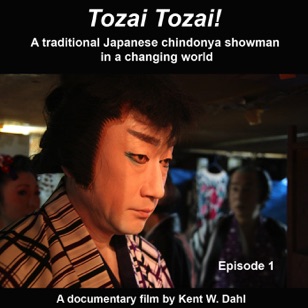

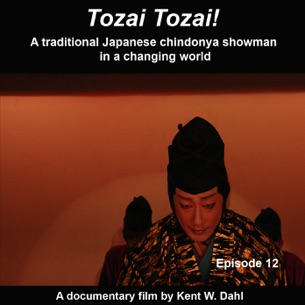

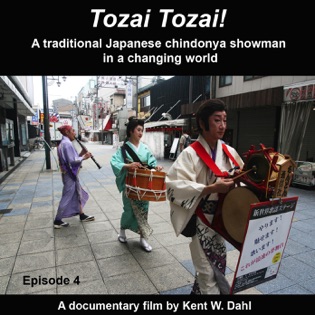

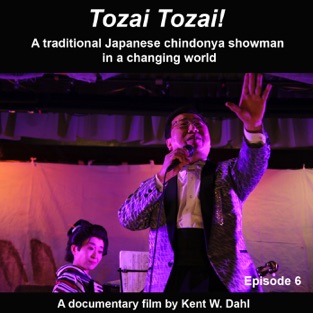
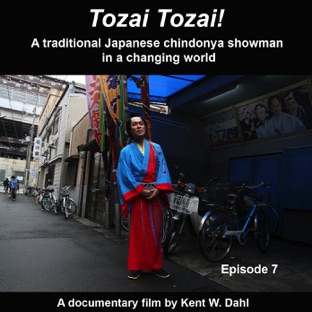
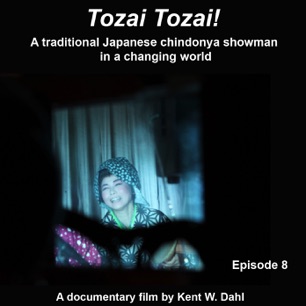
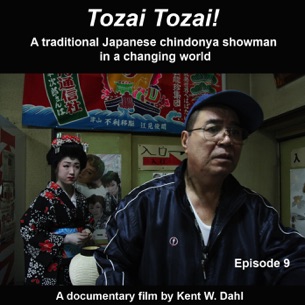


Tozai~ Tozai~ !
Ladies and Gentlemen from East to West
A Japanese showman in a changing world
A film by Kent W. Dahl
English version
12th episode
Kojiro Hayashi expands his repertoire to include a kyogen, a Japanese theatre form that developed as a comic interlude between or within solemn Noh plays. Tozaiya then make use of their music and acting skills, when participating in the Ozu Street Festival in Nagoya. In conclusion Hayashi’s daughter, Fumika Hayashi, talks about her wish, and at the same time hesitation, to lead Chindon Tsushinsha (Tozaiya) in the future.
<THE END>
ABOUT THE FILM
Frequenting traditional shopping districts in Japan, you will occasionally see some colourful musicians playing a catchy cocktail of New Orleans jazz, circus music, and wistful hits.
Welcome to chindonya, a distinctive form of Japanese advertising dating back to the 19th century. Traditionally hired by small shops, their job is to entice passers-by to spend their money.
Kojiro Hayashi is a veteran chindonya plying the streets of Osaka. He founded his company “Chindon Tsushinsha (Tozaiya) ” in 1984 after an eventful introduction to the profession in “deep” Osaka.
But Japanese society is changing. Chindonya’s core customers have been bruised by malls and online shops.
Hayashi thus tries to make his troupe into a vaudeville act, which can also do stage shows and concerts, while profiting from chindonya’s distinctive roots.
Drawing on the hard-earned chindonya training in his youth, Hayashi decides to hone his troupe’s performance skills in an old dilapidated theatre in Osaka.
The film consists of 12 episodes.
1st episode
Discloses how Kojiro Hayashi entered the Japanese chindonya world in Osaka.
Hayashi recounts the history of chindonya and harks back to his first job as a chindonya in the Kamagasaki area of Osaka. The biggest slum in Japan, which was primarily occupied by day labourers, gangsters, and sex workers from the adjoining red-light district—also the biggest in Japan. The area did not figure on most official maps and few people ventured there.
2nd episode
Continues Kojiro Hayashi’s recollections from the “deep” Kamagasaki area of Osaka. Hayashi describes how he started his Chindon Tsushinsha (Tozaiya) company and why the number of traditional chindonya customers later dwindled.
We meet his friend, Masato Kishimoto, who owns the OS Gekijo theatre in Kamagasaki, specializing in taishuengeki popular Japanese theatre. He introduces us to Masaki Ukai, who is an authority on popular Japanese entertainment. The two gentlemen introduce us to the colorful world of taishuengeki.
Hayashi and Ukai decide to stage a vaudeville show in OS Gekijo.
3rd episode
The Tozaiya members start to rehearse for their vaudeville performance, and we follow their preparation on-and- off during the next four episodes. We meet Hayashi’s daughter, Fumika Hayashi. Together with other chindonya members they give us their take on the definition of a chindonya. A stand-up comedian teaches Hayashi how to captivate his audience and we see this in practice during Hayashi’s appearance in a jazz festival.
4th episode
Hayashi tells us how he learned the chindonya trade and reveals the secret of being a professional chindonya. In between we see the progress of the Tozaiya-members preparation for their vaudeville show in the OS Gekijo theatre.
5th episode
Hayashi recollects the business and performance advice he got from his old mentor, and first boss, in Kamagasaki. We follow Hayashi on a traditional chindonya adverticing job in Osaka and hear him explain about the art of wearing a kimono. Former taishuengeki actor, Masaki Ukai, continues to teach Hayashi how to stage a chambara sword duel. Meanwhile the Tozaiya-members are trying to get their act together for their vaudeville show.
6th episode
Hayashi and the core members of his Tozaiya-group accompany singer, Takashi Taura, at his performance in an old taishuengeki theatre in Tokyo. Taura started his career at a young age working as a nagashi guitar player. He takes us back to his nightly beat in the bars of Osaka’s Tobita—the oldest and biggest red-light district in Japan. Hayashi gets his final lesson in chambara sword fighting and the Tozaiya-members are almost ready for their vaudeville show.
7th episode
The Tozaiya-members arrive at OS Gekijo theatre and prepares for their show. The curtain rolls aside and we see Tozaiya perform a variety of acts including music, singing, magic, and dancing. During the performance the camera sometimes switches backstage.
8th episode
Kojiro Hayashi and members of his Tozaiya-group act on stage. The play is based on an old Japanese story and rewritten by Kojiro Hayashi and popular entertainment professor Masaki Ukai. This episode is for diehard aficionados of traditional Japanese theatre. The sound quality is not the best at times due to noise from the heating system in the theatre. But if you enjoy the action you may not notice.
9th episode
The drama continues. In between Fumika Hayashi does a dance performance.
Chanson singer, Tama, gives her interpretation of Charles Aznavour’s world-famous song “La Boheme”.
At the same time; the camera lingers backstage on the “real bohemians.” The play continues and leads up to the climax, where Kojiro Hayashi and Masako Ukai stage a dramatic chambara sword duel in the next episode.
10th episode
Kojiro Hayashi and Masako Ukai prepare a fight backstage - then stage an exciting chambara sword duel, which is the climax of the play. The show continues with music, dance, and song. Then wends down with a honshi-gi traditional Japanese concluding of a party. The Tozaiya-members then greet their happy audience outside the theatre.
11th episode
The Tozaiya-members take stock and draw conclusions about what they have learned from staging their vaudeville show. Their new skills and confidence are utilised, when they are asked to replace a theatre troupe for a performance at an old peoples’ home.